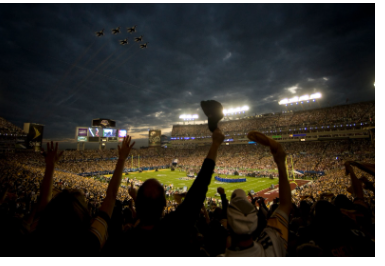Vintage Fashion Trends: Lacking Creativity or Appreciating the Past?
You hop in the car and head to your nearest thrift store, hunting for vintage levi jeans and corduroy, trends that seemed to have died years ago but have since risen from the grave. Sound familiar? Lettuce edged shirts, denim skirts, scrunchies – all back in style and popping up in fashion everywhere. So, the question begs to be asked, where is all of this coming from? Who decided these trends were ‘in’ and socially acceptable to sport again?
I’m sure you have noticed this kind of ‘recycled style’ throughout the past several years. We’ve all noticed things like mom jeans and Doc Martens have recently taken over fashion; I mean… it’s kind of hard to miss. As fashion is particularly hard to keep up with, I’ve taken it upon myself to dive into these resurrected trends to see where this cycle actually began, and I’ve discovered it really is just a matter of longing to live in the past. There is a plethora of nostalgia of what life was like before this modern world of technology, and these feelings have carried into modern fashion. Taking design inspiration from older times is not a new concept, though.
The truth is, we have always been recycling styles from the past. The way evolution works is things from the past are slightly altered and changed overtime to create a new idea or result. Fashion undergoes evolution; this is why trends don’t stay the same. What started to happen overtime, though, was this process of change began to repeat itself. Things from the past weren’t just evolving, but were being totally revived and hyped all over again.
Jeanne Lanvin was one of the first in doing this, creating an 18th century inspired dress in the 1900s. “She used a torso-widening silhouette, typical of the chosen period, and under the skirt she took on extra material that gave its wearer courage, a modern-looking blast, and extravagance,” (L’officiel.com.) In doing this, Lanvin created a spark, and this pattern continued all throughout the century. What’s important to realize as well is that it didn’t just rely on pure spontaneity.
Decisions like this that were made by high-end fashion designers seem to have actually depended on the state the world was in. For example, when WWII occurred, the women took on an overall masculinity as they adopted industrial jobs, so many designers sought to bring that femininity back through their projects. As shown through this process of design, clothing was being used to create a shared idea among consumers that contrasts the rest of the world due to current circumstances. It is to my judgement that this concept connects to the way we are recycling trends in today’s clothing, and let me explain why.
The majority of people may look at our current fashion trends and just assume that we are copying ideas from the past because we have run out of originality and inspiration. Emily Reddish, a senior at Bingham High School, responded to me when I asked her why these trends might be coming back into style by saying, “I think people just run out of new ideas and like to reminisce on old, popular styles that they have always liked.” Although at first glance this may seem like the simple truth, there is just a copious amount of inspiration from a specific span of about 40 years. If we were just out of ideas, then why haven’t we taken trends from the 1920s or the 1860s? This is how I’ve come to the conclusion that there is more to this direction of fashion than what we see on the surface. It is more of a matter of how our time compares to the decades we are taking influence from.
Our modern society is starkly different than the centuries and millennia before us. Today’s world runs dependently on ever-changing technology. We are incredibly reliant on our phones, absorbing media for hours on end, predominantly socializing through a screen. Our lifestyles are basically incomparable to everyone who lived before the internet and mobile phones. Although this advancement into a technological world has been remarkable, there is no question that it has come along with its downfalls.
Mental health has been on a constant decline since the release of the internet and mobile phones. Basic social skills have become neglected and social media has become the downfall of achieving self-security. Sure, we may all be familiar with these concepts, but what does it have to do with fashion trends?
What fashion designers, and consumers, are really doing is romanticizing the decades before the world became what it is today. We look back on the times right before any of this technology was invented and can’t even imagine what life might have been like. Back when mobile phones didn’t exist and people actually had to talk face-to-face, yet there remained a sense of thriving modern technology. They still had to put in real effort to be entertained, which overall led to more experiences and stories to tell. Understanding how this era of time compares to the world now, it will be easier to explain how recycled fashion ties into it.
We listen to ‘oldies’ music and throw 60s, 70s and 80s themed dances, nodding to these decades in the most glamorous ways more often than we might notice at first glance. We really idealize what it might have been like to live back in those times, and that’s why we enjoy these throwbacks. Each decade held a signature style that carried on into fashion, creating an iconic theme for each span of time. Modern clothing design has turned into a slideshow of sentimentality, bringing the feeling of living in these old times.
Fashion, being a form of self-expression, is allowing people to appreciate older times and live vicariously through their apparel styles. They create the feeling of living in a certain time by looking like they’re from said time. The aesthetic of living in a 1900s, idealistic utopia has carried into how we dress.
This being said, when did this kind of throwback fashion begin? If we look back to around 2010, this is when the concept of ‘mom jeans’ started to come back into trend. Mom jeans are high waisted, ankle length and usually baggy, or at least looser around the lower leg. They are also often a much thicker material than, say skinny jeans, because they are made from 98% or more cotton. This trend of denim seems to be one of the first major trends that circled back from the 1900s, specifically the 1980s. After this came back into the fashion industry, there was an overall craze of the 80s. Scrunchies, pegged jeans, bomber jackets and hair scarves have all made their way into the 2010-2020s as well.
Stranger Things, the Netflix Original Series, released in 2016, furthered this appreciation of the novelty that was the 80s. The popularity of this show took off not long after its release, and I believe a part of this acclamation came due to the fact that viewers adored the show’s aesthetic, as it was set in the 80s. When you just type in ‘Stranger Things’ into the search bar on Google, the first things to pop up are: ‘Stranger Things 80s,’ ‘Stranger Things outfits,’ ‘Stranger Things 80s clothes’ etc. It is almost a part of the show’s reputation to bring an 80s nostalgia along with each season.
After the release of this show, there was more of a fashion transition into other decades. With the appreciation of Stranger Things came recognition for shows and movies from the past that had a similar effect on viewers, highlighting the aesthetic of a past era. Twin Peaks and X-files are two shows that received a second life after Stranger Things. These take place more so in the 90s, though, showing an appreciation for the style and feeling of other decades as well.
The 90s, 70s, and even 1960s fads have since slowly made their way onto the runway. The feathered hair of the 70s and blowouts of the 60s can be seen all over Tik Tok. Even chunky highlights from the 90s have been revived, with what is known as ‘e-boys and e-girls.’ For boys, mullets made a big come-back, along with turtle necks and metal chains. If you are in junior high or high school, there is a good chance you have seen several, if not all of these trends around you.
As I see it, this enthusiasm for older fashions is not a result of a lack of inspiration and struggle for new ideas, but more-so the opposite. I consider these modern times to be a hurricane of new concepts, technology and invention. We have had so many years of constantly seeking contemporary concepts, it’s been perceivably exhausting to keep up with it. It is really nice to take a step back and reflect on the things before us. To me, it is pleasing to see the world’s appreciation for the past carry into the way we express and present ourselves to others.






Kirsten Hivon • Nov 7, 2022 at 3:57 am
Thanks. I really enjoyed that article. I have been wondering myself if the fashion industry has run out of ideas, hence the 80’s and 90’s comeback. But your article really made me think in a different way about it all. Great job. ?
kim campbell • Mar 24, 2021 at 11:20 am
This is a really well written, informative article. Thank you for sharing all of this information!